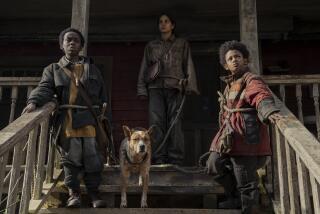Movie reviews: ‘Don’t Go in the Woods’ is an undercooked ‘Glee’ hybrid
If Stephen Sondheim and Brian De Palma had collaborated on a horror musical, they would never have made “Don’t Go in the Woods,” an undercooked, “Glee”-like hybrid of grating indie pop songs and forest slasher flick.
The people who did make it — debut feature director Vincent D’Onofrio, and screenwriters Sam Bisbee (responsible for the songs) and Joe Vinciguerra — operate under the lazy artistic assumption that simply touching chocolate and peanut butter together magically makes a Reese’s Cup.
Instead, a young all-male band of five ventures into wooded seclusion to concentrate on new material, whereupon they perform what sounds like the same whiny lament over and over, bicker, hook up with girls and get knocked off in turn by a masked killer.
Despite an initially pungent sense of thicket-y dread, nothing here is as unnervingly scary/funny as some of D’Onofrio’s great on-screen wackos (“Full Metal Jacket,” “Men in Black”), while the brief thematic lip service to the connection between inspiration and derangement feels like an indie-cred afterthought.
Tunes and terror have meshed before — note the Sondheim (“Sweeney Todd”) and De Palma (“Phantom of the Paradise”) shout-out — but “Don’t Go in the Woods” is only for those with sadistic fantasies toward emo musicians.
—Robert Abele
“Don’t Go in the Woods.” No MPAA rating. Running time: 1 hour, 23 minutes. At Laemmle’s Music Hall 3, Beverly Hills.
Out of war zone, her battle rages
“Return” is a tough and nuanced piece of Midwestern kitchen-sink realism, closely following a soldier’s uneasy readjustment to civilian life. As that National Guard reservist, Linda Cardellini appears in every scene, a flawed and relatable figure peering across a growing emotional divide.
Set in struggling small-town Ohio, the film is an implicit commentary on the economic realities surrounding America’s military, but it’s no treatise on war. With its modest scale and sharp observations, writer-director Liza Johnson’s first feature has the quiet impact of a short story.
The low-key drama finds Cardellini’s Kelli out of sync with the life that once fit her. Her plumber husband (Michael Shannon, convincingly decent, ill-equipped and weak) and her friends want to reduce her Middle East experience to something easily processed. Pushing pop-psychology buttons, they seek confessions to justify their own failings and betrayals.
All Kelli will say about her tour of duty is that “other people had it a lot worse,” but she’s in a state of growing emergency, signaled by the red clothing she favors, her increasingly impulsive behavior and the ferocity and self-containment of Cardellini’s performance.
John Slattery and Talia Balsam lend strong support as new people in Kelli’s life. Slattery’s off-the-grid Vietnam vet injects a welcome shot of energy into the story’s deliberate dreariness. His assessment of how soldiers have been treated upon returning home is one of the most cutting insights in a film that refuses to draw easy conclusions.
—Sheri Linden
“Return.” No MPAA rating. Running time: 1 hours, 37 minutes. At Laemmle’s Monica 4-Plex, Santa Monica.
Failing to find Halston
A self-indulgent pilgrimage to the shrine of ‘70s fabulousness, “Ultrasuede: In Search of Halston” assembles a fine assortment of archival material but falls far short of its stated goal. Halston, who died in 1990, is a compelling subject — a Midwesterner who became synonymous with Manhattan night life while changing the fashion industry — and his story helps to define an era. That story is trivialized in this glitter-deep overview of familiar Studio 54 terrain.
The film combines two documentary subgenres: the fashion doc and the inquisitive-filmmaker-inserted-in-every-scene doc. The spotlight-hogging director is star-struck first-timer Whitney Sudler-Smith. His on-screen contributions showcase how, over the two years of globe-trotting that it took to shoot the film, he switched up his personal retro style. That, combined with his clumsy interviewing, makes for a performance bordering on parody. (He asks Liza Minnelli if he can touch her Halston velvet pants. Graciously, she lets him.)
Driving the film over its many detours — such as an interview with Billy Joel, who mentioned Halston in a song — is Sudler-Smith’s acute longing for “that glamorous, decadent time” when pre-AIDS New York partied amid its ruins. It was a time when Halston took American fashion to new levels of casual elegance, as interviewees, and the still-influential designs themselves, attest. His groundbreaking licensing deals, controversial but prescient partnership with JCPenney and loss of his brand to a conglomerate — it’s all laid out, but with little sense of the man behind the empire.
“Ultrasuede” captures the period’s beautiful-people chic; Halston remains elusive.
—Sheri Linden
“Ultrasuede: In Search of Halston.” No MPAA rating. Running time: 1 hour, 33 minutes. At Laemmle’s Music Hall 3, Beverly Hills.
More to Read
The biggest entertainment stories
Get our big stories about Hollywood, film, television, music, arts, culture and more right in your inbox as soon as they publish.
You may occasionally receive promotional content from the Los Angeles Times.










